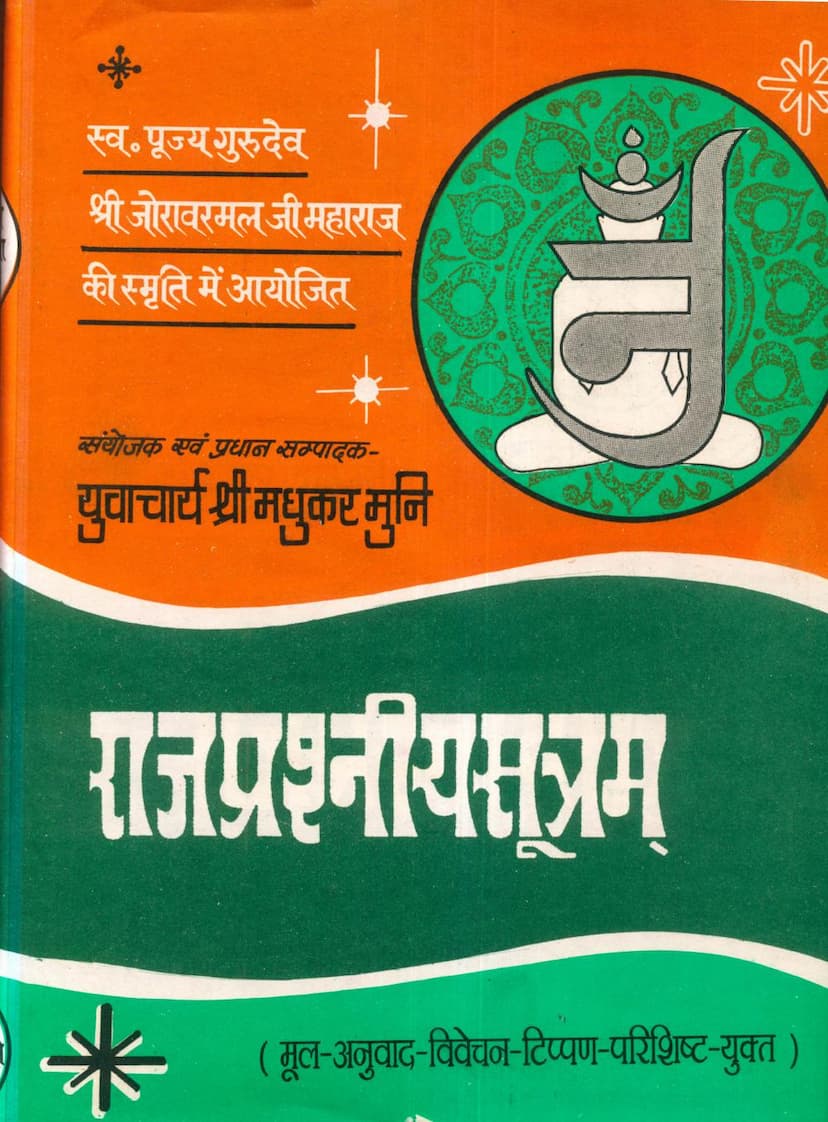Agam 13 Upang 02 Rajprashniya Sutra Stahanakvasi
Added to library: September 1, 2025

Summary
Here's a comprehensive summary of the Rajprashniya Sutra, based on the provided Jain text:
Book Title: Rajprashniya Sutra (राजप्रश्नीयसूत्रम्) Series: Jinagam Granthamala (जिनागम-ग्रन्थमाला), Publication No. 15 Upanga: Second Upanga (द्वितीय-उपाङ्गम्) Authors/Contributors:
- Inspiration: (Late) Swami Sri Brijlalji Maharaj
- Convener & Founder Editor: (Late) Yuvacharya Sri Mishrimalji Maharaj 'Madhukar'
- Translator & Annotators: Shri Ratan Muni, Deo Kumar Jain
- Direction: Sadhwi Shri Umrav Kunwar 'Archana'
- Board of Editors: Muni Shri Kanhaiyalalji 'Kamal', Acharya Shri Devendra Muniji Shastri
- Corrections and Supervision: Shri Dev Kumar Jain
- Publisher: Shri Agam Prakashan Samiti, Beawar (Rajasthan)
Introduction and Context:
The Rajprashniya Sutra is considered an Upanga (secondary scripture) to the second Anga, the Suta-kritanga Sutra. It is highly valued for its unique approach to explaining Jain philosophical tenets through engaging narratives and for showcasing aspects of ancient Indian arts and culture. The text is dedicated to the memory of Rev. Guru Shri Joravarmalji Maharaj, reflecting a lineage of scholarship and devotion within the Jain tradition.
Key Themes and Content:
The Rajprashniya Sutra is divided into two primary sections:
-
The First Part (Suryabhdeva's Narrative):
- Setting: The narrative begins in the city of Amalaka, located in Videsha, near Shvetambika. This city is described in great detail, emphasizing its prosperity, peace, security, and vibrant cultural life.
- Suryabhdeva's Appearance: Suryabhdeva, a celestial being from the Saudharma heaven, descends in his magnificent flying chariot (Vimana). The description of his Vimana is exceptionally detailed, highlighting its architectural grandeur, adorned with various gems, pillars, paintings, musical instruments, and seating arrangements for his retinue.
- Artistic Demonstrations: Suryabhdeva, inspired by the presence of Bhagwan Mahavir, orchestrates a spectacular display of ancient Indian arts. This includes:
- Music and Dance: A vast array of musical instruments (mentioned extensively, covering different categories like stringed, wind, and percussion) are played, accompanied by celestial musicians and dancers.
- Drama and Theatre: Thirty-two different types of dramatic performances (Natya Vidhis) are presented. These include:
- Symbolic Acting: Performances depicting auspicious symbols like Swastika, Srivatsa, Nandiavarta, etc.
- Figurative Acting: Portrayals of various animals (fish, crocodiles, elephants, horses, lions, serpents), mythical beings (Kinnaras), and natural phenomena (waves, seasons, lotuses).
- Abstract and Figurative Representations: Depictions of celestial events (sun and moon rise/set, eclipses), geometric patterns (circular, semi-circular), alphabetical forms, and artistic representations of natural elements like flowers and creepers.
- Biographical Dramas: Narratives from Bhagwan Mahavir's own life, including his renunciation, asceticism, enlightenment, and nirvana.
- Purpose of the Display: Suryabhdeva's intention is to express his devotion to Bhagwan Mahavir and to present a grand spectacle befitting the divine presence, thereby seeking spiritual merit.
-
The Second Part (King Pradeshi and Keshikumara Shramana):
- The Conversation: This section features a profound philosophical dialogue between King Pradeshi, who holds materialistic and atheistic views (accarya-vad), and Keshikumara Shramana, a highly learned disciple of Bhagwan Parshvanatha.
- King Pradeshi's Skepticism: King Pradeshi is depicted as a proud, argumentative, and ignorant ruler who believes that the soul and body are identical and that there is no afterlife or karmic consequence. He uses empirical observations (like the unchanged weight of a corpse in a sealed container) to justify his beliefs.
- Keshikumara Shramana's Arguments: Keshikumara Shramana systematically refutes Pradeshi's views using logical reasoning, analogies, and subtle explanations. He demonstrates the distinctness of the soul from the body, the existence of the soul through self-awareness, and the concept of karma and rebirth.
- Analogies Used: The text employs various analogies to illustrate complex philosophical points. For example, the unchanging weight of a corpse is explained by the unmanifested nature of the soul, and the visibility of sound through its effect on the air is used to explain the subtle existence of the soul.
- King Pradeshi's Transformation: Through the insightful discourse, King Pradeshi's rigid views are softened, and he begins to understand the Jain perspective. He ultimately embraces the path of righteousness and becomes a follower of Keshikumara Shramana.
- The Discussion on Knowledge (Jnana): The dialogue also touches upon the different types of knowledge in Jainism: mati, shruta, avadhi, manahparyaya, and kevala jnana, explaining their scope and limitations.
Literary and Cultural Significance:
- Artistic Depiction: The detailed descriptions of the celestial Vimana, the musical instruments, the dances, and the various dramatic performances offer valuable insights into the artistic and architectural standards of ancient India.
- Philosophical Depth: The dialogue between Keshikumara Shramana and King Pradeshi is a masterclass in philosophical debate, showcasing the Jain emphasis on logic, reasoning, and the subtle nature of reality.
- Ethical and Spiritual Guidance: The transformation of King Pradeshi serves as a powerful testament to the efficacy of righteous association (satsang) and profound spiritual guidance in overcoming ignorance and delusion.
- Historical Context: The text provides glimpses into the social and religious milieu of the time, mentioning various types of rulers, officials, festivals, and the prevalent philosophical debates.
Theological and Doctrinal Aspects:
- The Nature of the Soul: A central theme is the debate on the nature of the soul, contrasting materialistic views with the Jain concept of the soul as a distinct, eternal, and conscious entity.
- Karma and Rebirth: The discussions implicitly or explicitly address the principles of karma and rebirth, emphasizing the consequences of actions and the possibility of liberation through righteous conduct.
- Ahimsa and Righteousness: The importance of moral conduct, the refutation of atheistic views, and the embrace of Jain principles are highlighted through the narrative arc.
Overall Value:
The Rajprashniya Sutra is a rich repository of Jain philosophy, ancient Indian art, and ethical teachings. Its narrative style makes profound philosophical concepts accessible and engaging, making it an essential text for understanding Jainism and its cultural context. The text underscores the Jain belief in the power of right knowledge, righteous conduct, and the potential for spiritual transformation through association with enlightened beings.